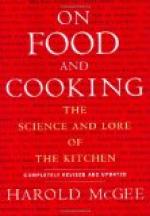PULLED BREAD.—Remove a loaf from the oven when about half baked, and lightly pull the partially set dough into pieces of irregular shape, about half the size of one’s fist. Do not smooth or mold the pieces; bake in a slow oven until browned and crisp throughout.
WHOLE WHEAT BREAD.—The materials needed for the bread are: one pint of milk, scalded and cooled, one quart of wheat berry flour, one pint Minnesota spring wheat flour, one third cup of a soft yeast, or one fourth cake of compressed yeast, dissolved in one third cup of cold water. Stir enough flour into the milk to make a stiff batter, put in the yeast, and let it rise until foamy. Have the milk so warm that, when the flour is put in, the batter will be of a lukewarm temperature. Wrap in a thick blanket, and keep at an equable temperature. When light, stir in, slowly, warm flour to make a soft dough. Knead for fifteen minutes, and return to the bowl (which has been washed and oiled) to rise again. When risen to double its size, form into two loaves, place in separate pans, let rise again, and bake from three fourths to one and one half hours, according to the heat of the oven.
WHOLE-WHEAT BREAD NO. 2.—Scald one pint of unskimmed milk; when lukewarm, add one half cup of liquid yeast, or one fourth cake of compressed yeast, dissolved in one half cup of warm water, and a pint of Pillsbury’s best white flour. Beat this batter thoroughly, and allow it to rise. When well risen, add three and two thirds cups of wheat berry flour. Knead thoroughly, and allow it to become light in mass; then shape into two loaves, allow it to rise again, and bake.
MISS. B’S ONE-RISING BREAD.—Sift and measure three and three fourths cups of wheat berry flour. Scald and cool a pint of unskimmed milk. When lukewarm, add one tablespoonful of lively liquid yeast. By slow degrees add the flour, beating vigorously until too stiff to use a spoon, then knead thoroughly for half an hour, shape into a loaf, place in a bread pan, cover with a napkin in warm weather, wrap well with blankets in cold weather, and let rise over night. In the morning, when perfectly light, pat in a well heated oven, and bake.
POTATO BREAD WITH WHOLE WHEAT FLOUR.—Take a half gill of liquid yeast made as for Boiled Potato Yeast No. 2, and add milk, sterilised and cooled to lukewarm, to make a pint. And one cup of well-mashed, mealy potato and one cup of white flour, or enough to make a rather thick batter Beat thoroughly, cover, and set to rise. When well risen, add sufficient whole-wheat flour to knead. The quantity will vary somewhat with the brand of flour used, but about four and one fourth cupfuls will in general be needed. Knead well, let it rise in mass and again in the loaf, and bake.
RYE BREAD.—Prepare a sponge over night with white flour as for Water Bread. In the morning, when light, add another tablespoonful of sugar, and rye flour to knead. Proceed as directed for the Water Bread, taking care to use only enough rye flour to make the dough Just stiff enough to mold. Use white flour for dusting than kneading board, as the rye flour is sticky.




